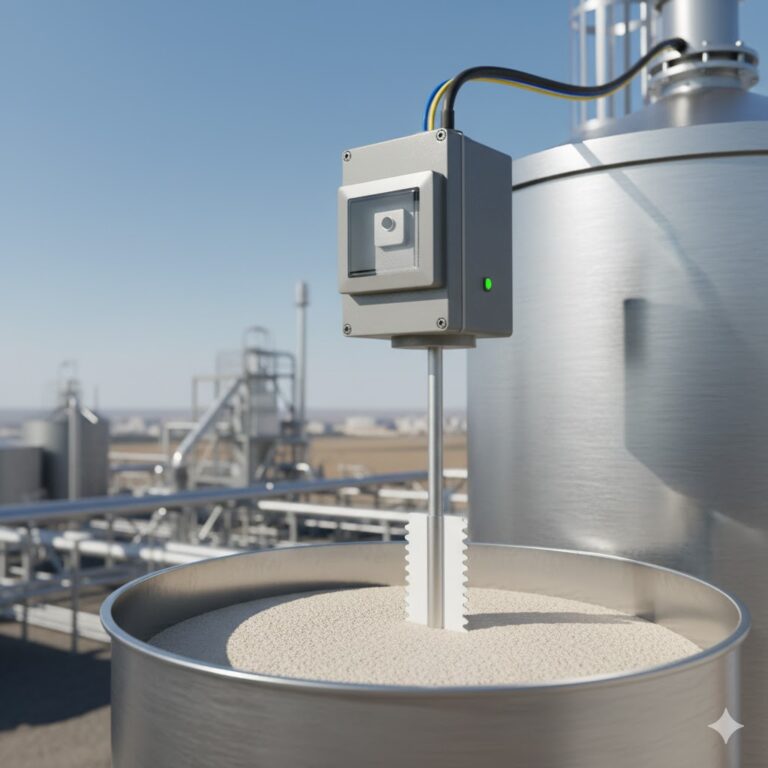A rotary paddle level switch is an instrument used to detect the level of solid materials (such as grains, powders) in various industries like storage, chemicals, and food processing. Below is an overview of its working principle and common troubleshooting methods:
1. Working Principle
The rotary paddle level switch mainly consists of a motor, gearbox, paddle (detection blade), and control circuit.
Normal State: The motor drives the paddle to rotate through the gearbox (typically at around 10 rpm). In this state, the circuit outputs a normal signal (such as no contact output or low-level signal).
Level Trigger: When the material rises and contacts the paddle, the paddle stops rotating, causing a sudden increase in motor load. This triggers an internal limit switch, outputting an alarm signal (such as contact closure or a high-level signal) to indicate that the set level has been reached.
Reset: When the material level drops and the paddle is no longer obstructed, the motor automatically resets and resumes rotation, and the alarm signal is cleared.

2. Common Faults and Troubleshooting Methods
Paddle Does Not Rotate
Possible Causes:
Motor failure or power supply issues.
Gearbox blockage (e.g., foreign objects, inadequate lubrication).
Paddle entangled or blocked by material (e.g., fibrous materials).
Troubleshooting:
Check the power supply voltage and ensure the motor is not open (use a multimeter to measure resistance). Replace the motor if necessary.
Open the gearbox, remove foreign objects, and apply high-temperature grease (for high-temperature environments).
Clean any material entangled on the paddle and replace with an anti-winding paddle (e.g., serrated blade).
False Alarm (Alarm when No Material Present)
Possible Causes:
Loose or deformed paddle touching the housing during rotation.
Sensitivity set too high (slight resistance triggers alarm).
Internal limit switch failure (e.g., sticking).
Troubleshooting:
Tighten or correct the deformed paddle.
Adjust the sensitivity knob (turn clockwise to increase resistance threshold).
Replace the limit switch or clean the contact surfaces to remove oxidation.
No Alarm (Signal Missing when Material is Full)
Possible Causes:
Severe paddle wear (e.g., paddle broken or detached due to material impact).
Limit switch failure (e.g., spring fatigue, failure to trigger).
Material adhesion, preventing the paddle from fully stopping (e.g., wet powder).
Troubleshooting:
Replace with high-strength paddles (e.g., stainless steel material) and increase paddle thickness.
Replace the limit switch spring, and check if the contact points are making proper connections.
Add a paddle cleaning device (e.g., scraper) or switch to a paddle with an anti-adhesion coating.
Motor Overheating and Damage
Possible Causes:
Material frequently obstructing the paddle, causing motor overload.
Excessively high ambient temperatures (exceeding the motor’s tolerance).
Troubleshooting:
Regularly check material flow and ensure there are no blockages.
Install overload protection devices (e.g., thermal relays).
Replace with a high-temperature-resistant motor (e.g., one capable of handling temperatures above 150°C), or install heat sinks and forced ventilation.

3. Daily Maintenance Tips
Regularly clean the paddle to prevent material buildup and blockage.
Check the lubrication of the gearbox every 3 to 6 months and replenish with the appropriate grease.
For corrosive materials, use stainless steel paddles and housings (e.g., 316L) to prevent rusting.
Ensure that the paddle is installed with a gap of at least 100mm from the silo wall to avoid false alarms caused by wall contact.
By following these methods, you can effectively reduce the faults of rotary paddle level switches and ensure their stable operation.
